Mammals
Type of resources
Available actions
Topics
Keywords
Contact for the resource
Provided by
Years
Formats
Representation types
Update frequencies
status
Service types
-
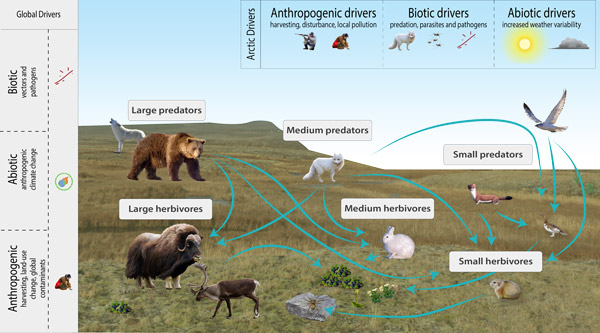
Conceptual model of Arctic terrestrial mammals, showing FECs, interactions with other biotic groups and examples of drivers and attributes relevant at various spatial scales. STATE OF THE ARCTIC TERRESTRIAL BIODIVERSITY REPORT - Chapter 3 - Page 67 - Figure 3.28
-
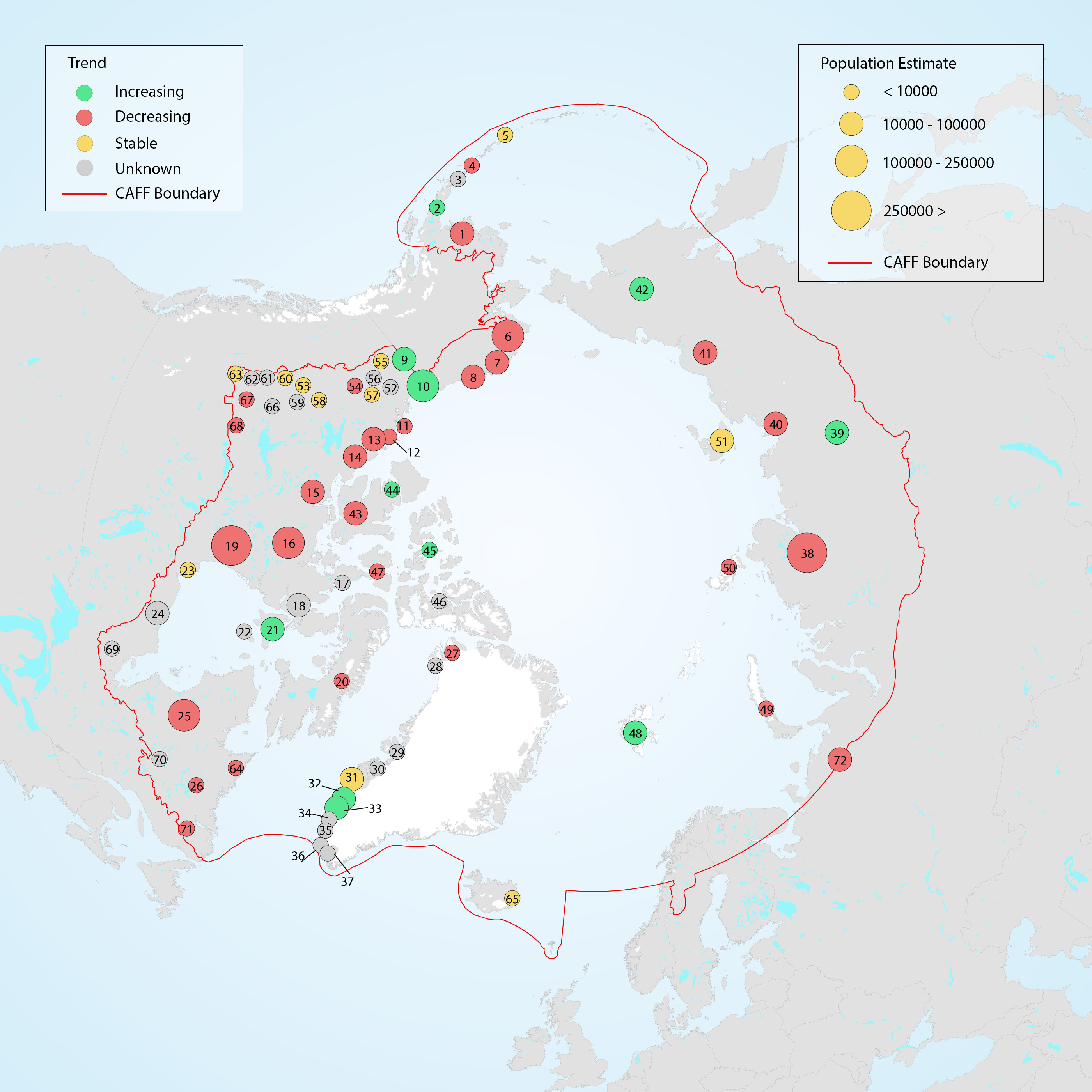
Several smaller populations of caribou inhabit sub-Arctic portions of Alaska, including five populations along the Aleutian Archipelago and west coast. These populations are considered part of the migratory tundra ecotype based on genetics, although in some instances their ecology and habitat are similar to the mountain caribou ecotype found in western Canada. Population dynamics and trends for these populations are variable (Figure 3-29). They are managed by the Alaska Department of Fish and Game through hunting quotas. STATE OF THE ARCTIC TERRESTRIAL BIODIVERSITY REPORT - Chapter 3 - Page 72 - Figure 3.29
-
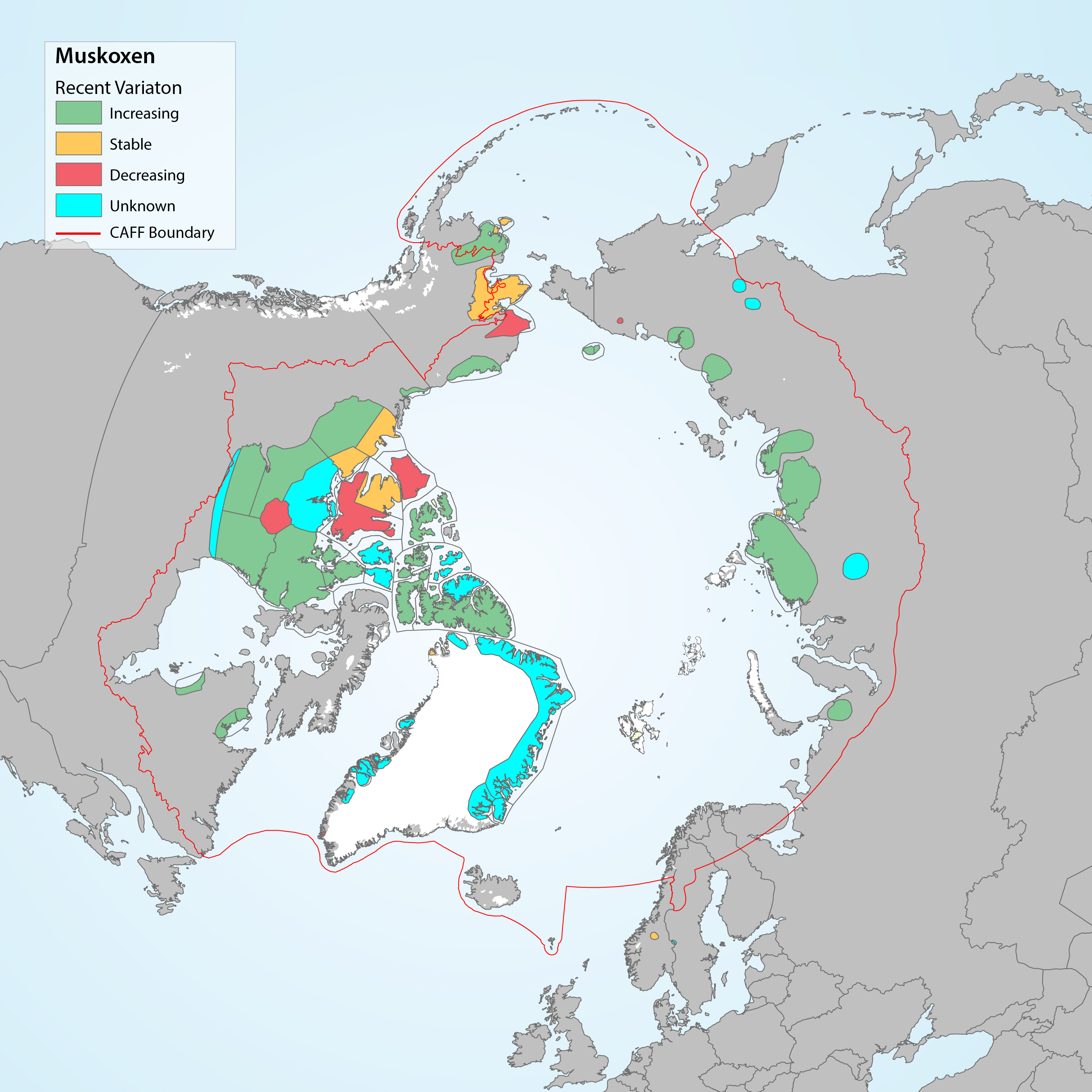
Trends and distribution of muskoxen populations based on Table 3-5. Modified from Cuyler et al. 2020. STATE OF THE ARCTIC TERRESTRIAL BIODIVERSITY REPORT - Chapter 3 - Page 79 - Figure 3.30
-
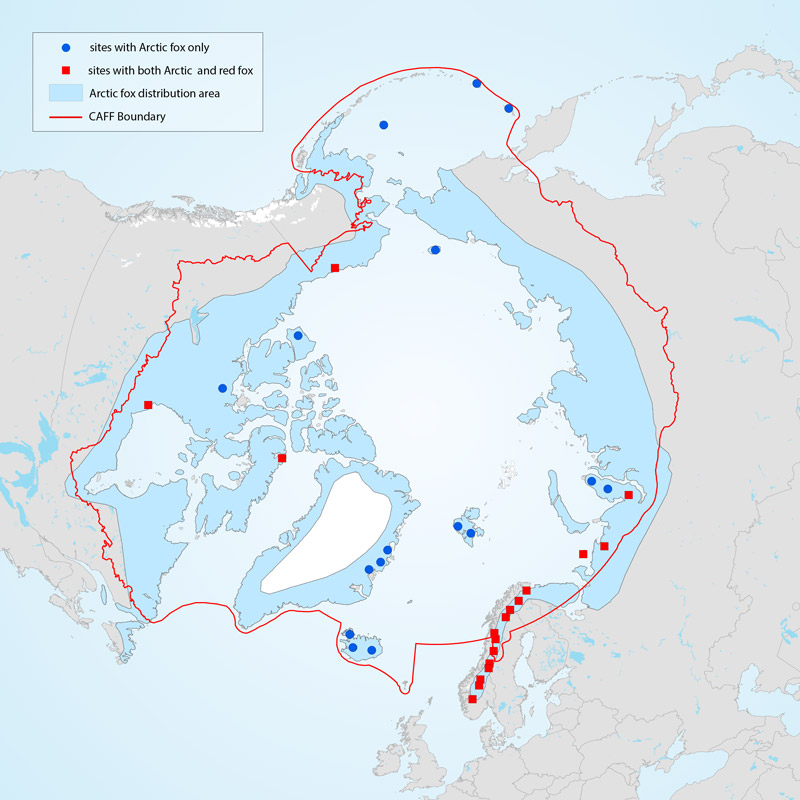
Arctic foxes are currently monitored at 34 sites throughout the North, with most monitoring efforts concentrated in Fennoscandia (Figure 3-32). The duration of monitoring across all sites is variable at between 2 and 56 years and was ongoing at 27 of the 34 sites (79%) as of 2015. Monitoring projects cover almost equally the four climate zones of the species’ distribution—high Arctic, low Arctic, sub-Arctic, and montane/alpine. STATE OF THE ARCTIC TERRESTRIAL BIODIVERSITY REPORT - Chapter 3 - Page 82 - Figure 3.32
-
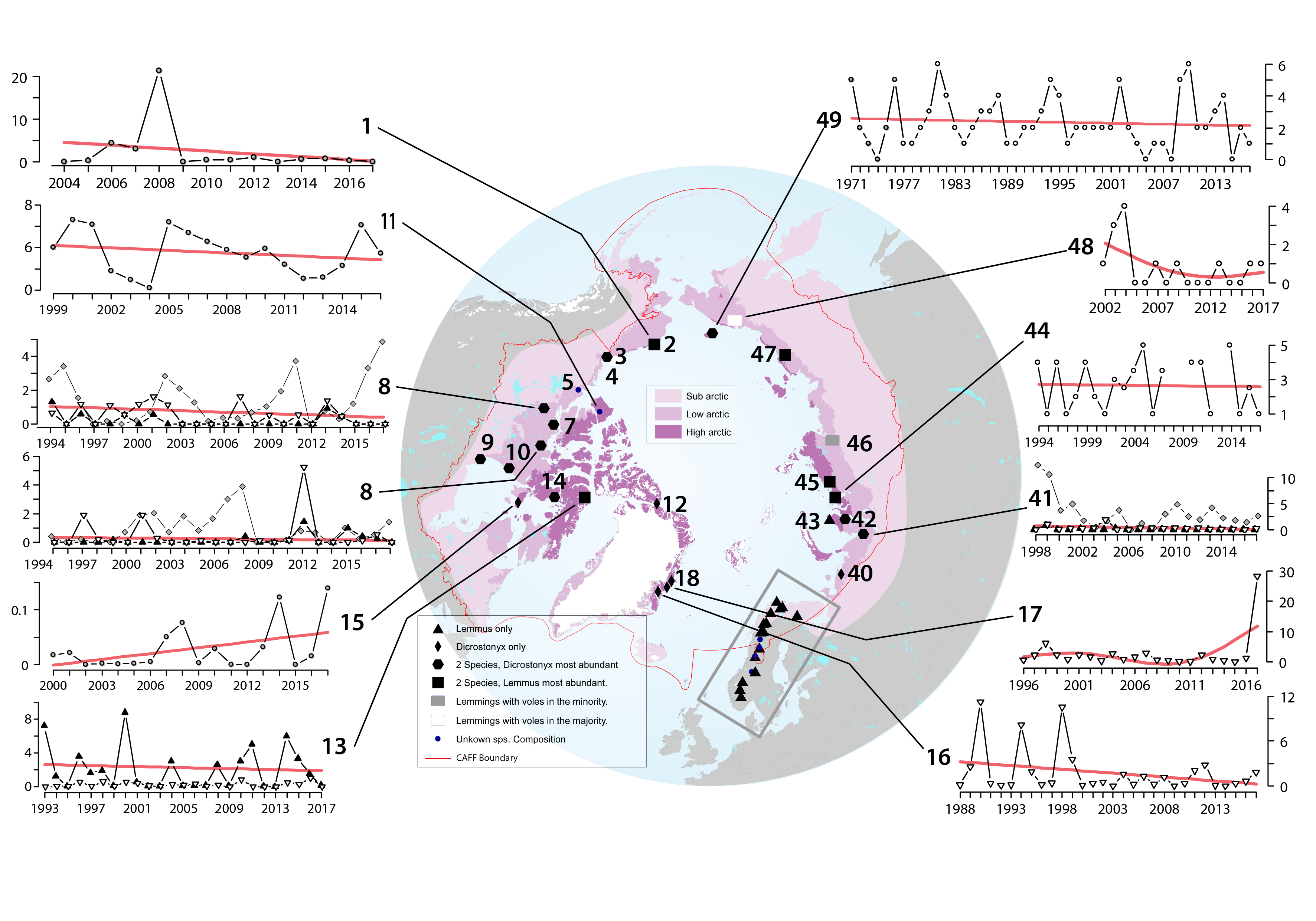
Lemmings are currently being monitored at 38 sites. Their status and trends were determined based on data from these sites as well as recent data (since 2000) from an additional 11 previous monitoring sites (Figure 3-31). Of those sites monitored, Fennoscandia is overrepresented relative to the geographical area it covers, whereas Russia is underrepresented. Based on the skewed geographical coverage, more information is available for some species of lemmings than others, particularly the Norwegian lemming. STATE OF THE ARCTIC TERRESTRIAL BIODIVERSITY REPORT - Chapter 3 - Page 80 - Figure 3.31
-

Population estimates and trends for Rangifer populations of the migratory tundra, Arctic island, mountain, and forest ecotypes where their circumpolar distribution intersects the CAFF boundary. Population trends (Increasing, Stable, Decreasing, or Unknown) are indicated by shading. Data sources for each population are indicated as footnotes. STATE OF THE ARCTIC TERRESTRIAL BIODIVERSITY REPORT - Chapter 3 - Page 70 - Table 3.4
-

Species characterization by environmental DNA (eDNA) is a method that allows the use of DNA released into the environment by organisms from various sources (secretions, faeces, gametes, tissues, etc.). It is a complementary tool to standard sampling methods for the identification of biodiversity. This project provides a list of fish and marine mammal species whose DNA has been detected in water samples collected between 2019 and 2021 using the mitochondrial marker MiFish (12S). The surveys were carried out in the summer of 2019 (July 14-18) and (July 30 - August 5), in the fall of 2020 (October 27-28) and in the summer-fall of 2021 (May 31 - June 3 ) and (August 24-25) between Forestville and Godbout (Haute-Côte-Nord). Sampling was carried out between 1-50 meters depth in 91 stations, with 1 to 3 replicates per station. Two liters of water were filtered through a 1.2 µm fiberglass filter. DNA extractions were performed with the DNeasy Blood and Tissues or PowerWater extraction kit (Qiagen). Negative field, extraction and PCR controls were added at the different stages of the protocol. The libraries were prepared either by Génome Québec (2019, 2020) or by the Genomics Laboratory of the Maurice-Lamontagne Institute (2021), then sequenced on a NovaSeq 4000 PE250 system by Génome Québec. The bioinformatics analysis of the sequences obtained was carried out using an analysis pipeline developed in the genomics laboratory. A first step made it possible to obtain a table of molecular operational taxonomic units (MOTU) using the cutadapt software for the removal of the adapters and the R package DADA2 for the filtration, the fusion, removal of chimeras and compilation of data. The MOTUs table was then corrected using the R package metabaR to eliminate the tag-jumping and take contaminants into consideration. Samples showing a strong presence of contaminating MOTUs were removed from the dataset. The MOTUs were also filtered to remove all remaining adapter sequences and also retain only those of the expected size (around 170 bp). Finally, taxonomic assignments were made on the MOTUs using the BLAST+ program and the NCBI-nt database. Taxonomic levels (species, genus or family) were assigned using a best match method (Top hit), with a threshold of 95%. Only assignments at the level of fish and marine mammals were considered, and the taxa detected were compared to a list of regional species, and corrected if necessary. The species detections of the different replicas have been combined. The file provided includes generic activity information, including site, station name, date, marker type, assignment types used for taxa identification, and a list of taxa or species. The list of taxa has been verified by a biodiversity expert from the Maurice-Lamontagne Institute. This project was funded by Fisheries and Oceans Canada's Coastal Environmental Baseline Data Program under the Oceans Protection Plan. This initiative aims to acquire baseline environmental data that contributes to the characterization of significant coastal areas and supports evidence-based assessments and management decisions to preserve marine ecosystems. Data were also published on SLGO platform : https://doi.org/10.26071/ogsl-2239bca5-c24a
-

Fisheries and Oceans Canada and Environment and Climate Change Canada (Northern Contaminants program) have been working with Nunavut community Hunters and Trappers Organizations and the Nunavut Wildlife Management Board consistently since 1980 to collect samples from harvested ringed seals. The majority of seals were measured in the field by Inuit hunters who recorded date of kill, sex and blubber depth at sternum (0.5 cm). The data from the harvested animals are used to evaluate stressors and overall seal health, in the Canadian Arctic.
-
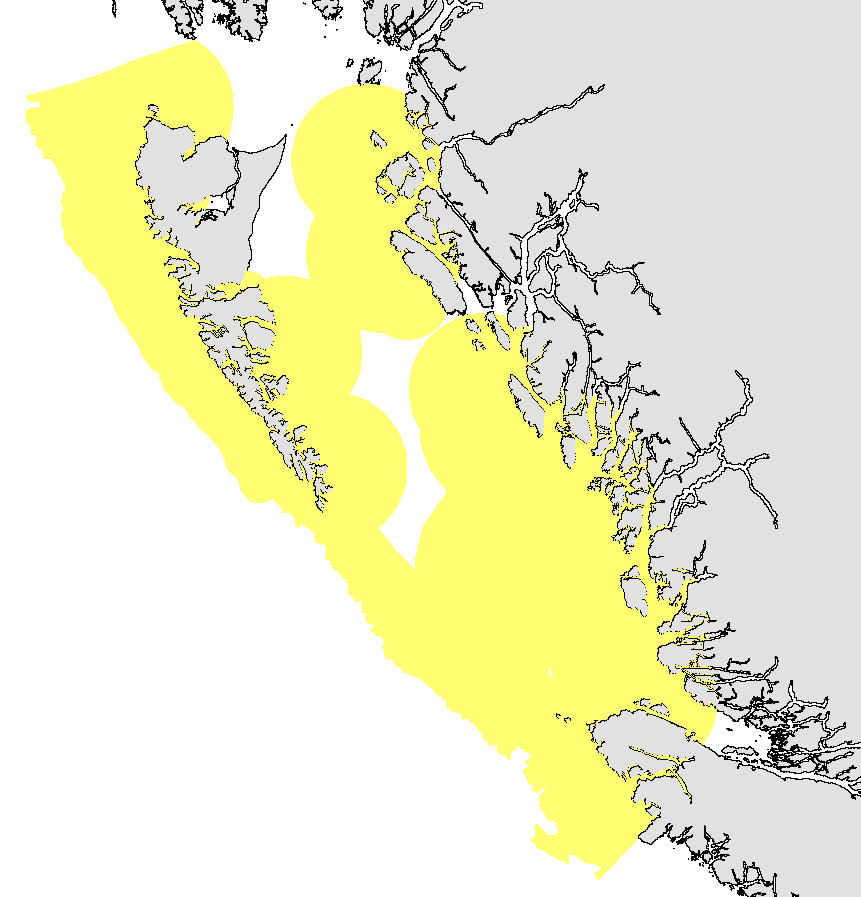
This layer details Important Areas (IAs) relevant to key vertebrate species other than fish and cetaceans in the Pacific North Coast Integrated Management Area (PNCIMA). This data was mapped to inform the selection of marine Ecologically and Biologically Significant Areas (EBSA). Experts have indicated that these areas are relevant based upon their high ranking in one or more of three criteria (Uniqueness, Aggregation, and Fitness Consequences). The distribution of IAs within ecoregions is used in the designation of EBSAs. Canada’s Oceans Act provides the legislative framework for an integrated ecosystem approach to management in Canadian oceans, particularly in areas considered ecologically or biologically significant. DFO has developed general guidance for the identification of ecologically or biologically significant areas. The criteria for defining such areas include uniqueness, aggregation, fitness consequences, resilience, and naturalness. This science advisory process identifies proposed EBSAs in Canadian Pacific marine waters, specifically in the Strait of Georgia (SOG), along the west coast of Vancouver Island (WCVI, southern shelf ecoregion), and in the Pacific North Coast Integrated Management Area (PNCIMA, northern shelf ecoregion). Initial assessment of IAs in PNCIMA was carried out in September 2004 to March 2005 with spatial data collection coordinated by Cathryn Clarke. Subsequent efforts in WCVI and SOG were conducted in 2009, and may have used different scientific advisors, temporal extents, data, and assessment methods. WCVI and SOG IA assessment in some cases revisits data collected for PNCIMA, but should be treated as a separate effort. Other datasets in this series detail IAs for birds, cetaceans, coral and sponges, fish, geographic features, and invertebrates. Though data collection is considered complete, the emergence of significant new data may merit revisiting of IAs on a case by case basis.
-

Several smaller populations of caribou inhabit sub-Arctic portions of Alaska, including five populations along the Aleutian Archipelago and west coast. These populations are considered part of the migratory tundra ecotype based on genetics, although in some instances their ecology and habitat are similar to the mountain caribou ecotype found in western Canada. Population dynamics and trends for these populations are variable (Figure 3-29). They are managed by the Alaska Department of Fish and Game through hunting quotas STATE OF THE ARCTIC TERRESTRIAL BIODIVERSITY REPORT - Chapter 3 - Page 72- Figure 3.29
 Arctic SDI catalogue
Arctic SDI catalogue